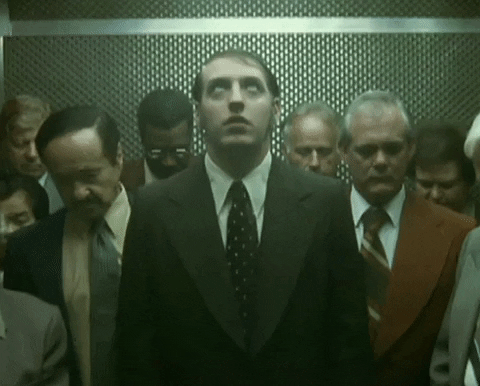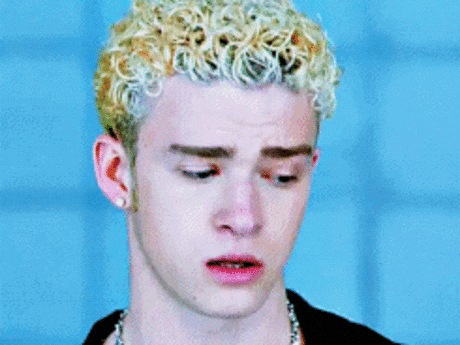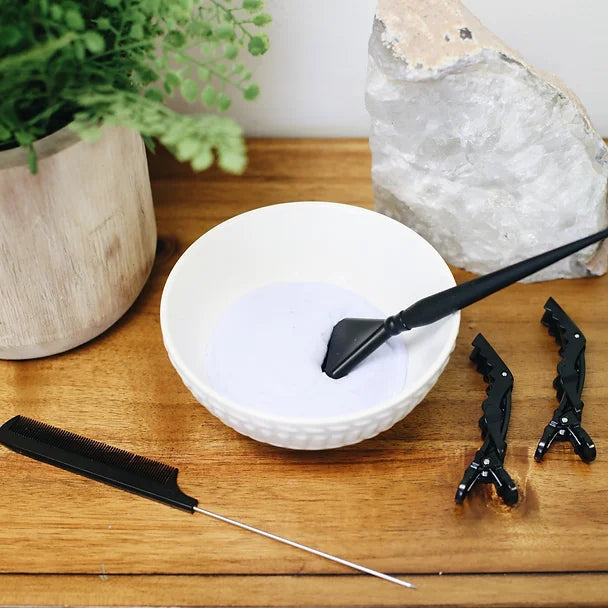
The question I am most frequently asked at the salon by people looking to get their hair colored is "can this be done without bleach," or "will you need to cut-down my hair to achieve this color?" I have tried to answer this question in many ways throughout my career and, with the Internet literally in our hands, I thought this information would be easier to find. To my surprise, there isn’t enough easy-to-read information on the internet for someone new to hair color. And, to make things worse, hairdressers in the country have been claiming to do "no-bleach hair color." 🤦♀️ So, I thought, why not explain the process to you?
Before we get on this journey to the science of hair coloring, I want to define the word 'bleach', as outlined by the Oxford Dictionary (in Pakistan, the very morbid term used for bleaching hair is somehow "cut down" and I have no idea where it came from – I am always amused when I hear it). Please also note that I am not covering henna-based colorants in this blog post as I they are a different topic I plan on addressing in a future blog post.
a chemical that is used to make something become white or pale and as a disinfectant (to prevent infection from spreading)
In this blog post, I'll be taking you through the process of hair color in the simplest terms that I can put them in. As a colorist in the industry for over 15 years, I believe it's time to impart knowledge about the chemicals, products, and tools we use so you can make better decisions for your hair.
What are the options I have when I color my hair?
When you color your hair for the first time, your hair will go through a process that involves changing what's naturally present and introducing a new color. There are generally 4 options you'll have when coloring your hair and each comes with its own set of products and techniques that can be used to achieve the desired color. Let's go through these briefly:
-
Going lighter than your natural hair color: In Pakistan, the most common request is to go lighter. This is primarily because, as a race, we have predominantly darker colored hair (yes, we do have many with lighter natural hair as well, but they are easily a minority when it comes to natural hair color). Even if you go from your natural hair color to just a teeny, tiny, minuscule shade lighter, we are going to count it as going lighter.
- Products normally used: Permanent dye (with or without ammonia), bleach, and demi-/semi-permanent hair color. -
Going darker than your natural hair color: It's rare to come across someone looking to go darker on their natural hair, but it does happen at times – especially if the person's natural hair color is on the lighter side or if they have gotten greys and are looking to cover them up with a deeper color than the greys themselves.
- Products normally used: Permanent dye (with or without ammonia), deposit-only dyes, demi-/semi-permanent hair color. -
Staying in the same depth but changing the tone of your natural hair color: This option can vary based on what your natural hair color is. If it's naturally dark, then both permanent and demi-/semi-permanent dyes can be used to achieve subtle hues of color, such as blue-black or even deep plum. Temporary chalks and sprays can be used to show a vivid difference. If your natural hair is a dark blonde or lighter, you can use semi-permanent colors to create different tones in your hair. You can also use demi-permanent and permanent dyes to achieve deeper hues or tonal changes.
- Products normally used: Permanent dye (with or without ammonia), deposit-only dyes, demi-/semi-permanent hair color. -
A combination of the above options: Of course, the option of mixing up the options above is also there (which is the case when we highlight, lowlight, or balayage).
- Products normally used: Permanent dye (with or without ammonia), bleach, deposit-only dyes, demi-/semi-permanent hair color.
How does hair coloring work?
Before we get into the science behind hair coloring, it would be wise to learn about the structure of a hair strand:
Hair Structure

Each hair strand can be thought of as having 3 layers:
- Medulla: This is the innermost layer of the hair. Surprisingly, very little is actually known about it (some hair strands don't even have a medulla 🤷♀️. Since it's not directly related to the subject of this post, so we're going to ignore it in our discussion.
- Cortex: This is the middle layer of the hair and it surrounds the medulla. This is where your hair color (melanin) is found.
- Cuticle: The outermost layer of the hair. Under a microscope, you can see that it is formed of scales (these are dead cells!). These scales protect the cortex and medulla. The tighter these scales are shut, the healthier and shinier the hair is, while a rough or lifted cuticle indicates damage.

The Coloring Process
When we think of hair coloring and hair health, the cortex and the cuticle of the hair are the most important. Now that we've seen what each hair strand is made of, let me explain hair color with an analogy I use to explain hair color.
In order to get into an elevator, you need the door to open, right? Think of the elevator door as the cuticle (protects the inside of the lift by staying shut) and the people inside of the lift as the cortex (contains hair color pigment).

When we change our natural hair color with ANY product that is permanent/semi-permanent, we need to open up the cuticle somehow so we could get to that natural hair color on the inside. The elevator doors need to open so that the people (or the natural color inside) could get out.
Hair has a natural pH of 4.5 - 5.5, meaning it is slightly acidic on the pH scale. In order to open the door (or cuticle) to hair coloring, there needs to be an alkaline agent to raise or adjust the pH to a higher level so that the fun coloring part could begin! This alkaline agent is most commonly ammonia, but alternatives like monoethanolamine (MEA) or ME+ are also used by some manufacturers. Regardless of what alkaline agent you use, it is necessary to use one in order to open the cuticle for us to change the color inside.
Now that the door to the elevator is open, the people inside the lift (or the natural color molecules inside your hair) don't want to leave. You're going to have to use some force to get them out, or they'll just be hanging around, not leaving any space for new people (or the new color).

To get this natural pigment out, we use an oxidative agent (in hair coloring, we use hydrogen peroxide, also known as developer). This is where we use the new word we learnt today... bleach! Hydrogen peroxide is a bleaching agent and, I promise you, every single time you have used a permanent or demi-/semi-permanent dye on your hair (even if you're going black), you have to use developer to get the natural pigment out of the hair! Remember, to bring new people into an already full elevator, you need to get the existing people out. The strength of hydrogen peroxide (or bleaching agent) used will depend on the amount of change required (higher strength for lighter shades and, generally, lower strength for darker shades or mild depositing of other shades).
The doors are open and the people are out. This is where the dye precursors (little molecules that will react with the alkaline agent, developer, and other ingredients in the dye) go inside and stay in there until the right color is achieved in the recommended duration. In the case of permanent dyes, the molecules interact with each other and, when the time is over, they form larger color molecules which are hard to wash out.
At the end of all this, the hair is washed with a pH balancing (acidic) shampoo and conditioner to try and normalise or 'close' the cuticle again.
Can I actually change my hair color without the use of bleach?
The answer to this question depends on the type of change being created and the products being used:
- If you are using a permanent or demi-/semi-permanent dye or a direct/high lift dye, you are using hydrogen peroxide which, by definition, is a bleaching agent
- If you are using a temporary colorant that will wash away with shampoo, you are not using bleach
But wait a minute, doesn't bleached hair look like this?

And isn't it very damaged after bleaching?
I know that when people are asking me the famous "will you be bleaching my hair" question, they're picturing Justin Timberlake's yellow blonde hair from the early 00s... and then the damage that comes with that. You can rest assured, the bleach in hair dyes won't be doing this to your hair (unless you end up with someone seriously inexperienced). Hair dyes can only lighten hair by around 3-4 shades or levels. For most Asians with naturally dark brown/black hair, this means that permanent hair dyes will only be taking you to light browns, red tones, plums, violets, and even dark blonde if your hair is not very resistant.
The Justin Timberlake yellow happens when you use a lightener (usually an ammonia based powder or paste) and developer together - meaning just the alkaline agent and oxidising agent are present, but there is no dye precursor. Leaving this on the hair will keep making it lighter and, eventually, dissolving any color molecules in the hair. We manually put in the color that we are looking to achieve after we have reached the desired lightness with the lightener and developer mixture. This process of using a lightener to lighten the hair and then manually adding the desired color is called 'bleach and tone' or 'decolorising and recolorising' and is used when you want to go more than just a shade or two lighter OR when we are doing corrective color.
How do some colorists claim to not use bleach and still achieve bold results?
I believe the answer is twofold. On one hand, we've got those colorists who don't know the science behind the color and, hence, don't know that 'bleaching' doesn’t just mean using a powder lightener with a developer. These colorists use products like high-lift dyes (dyes with a greater potential of lightening) or lighteners with pre-mixed pigments and, just because it didn't look like Justin's hair in the end, they think they're not bleaching it. But, alas, as we learnt in this very long blog post, we're always bleaching if the change is going to be permanent or demi-/semi-permanent!
On the other hand, we've got the liars. These are, unfortunately, not rare to find and have tarnished the reputation of this field for far too long. People lie for many reasons and I honestly don't understand what the big deal is if you tell someone that a bleaching agent is always present when making changes to the hair's cortex. If we think of bleaching as a controlled process that is in trained and experienced hands, it really isn't something anyone needs to lie about or be scared of - especially with the quality and variety of products now available to colorists globally.
I'm all for being a risk-taker and doing things a different way, but when it comes to chemicals and hair, there's no fooling around. It's crucial that I share vital information about the tools and products that I am using and making sure I use them in a safe and authorised way.
So, what now? How do I change my color if I am always bleaching it?!
My aim with this blog post was to give you a better understanding of hair color and the basic science behind the art of hair color. By now, you have hopefully seen how, whenever we're coloring hair to make long-term changes, we're always using a version of bleach.
Bleach has a bad reputation for the right reasons. But, from what I've seen in these years behind the chair, most people are doing a lot worse stuff to their hair than bleaching it! When we color our hair, the change is visible for a long stretch of time. It goes without saying, it will account for a good chunk of how you look and feel. If you're chemically straightening or perming your hair or heat styling it, you are damaging the cuticle even then. So, no matter which boat you're in, you're always changing hair by altering the cuticle and its health. The upside of bleaching hair is that it is so customisable; it can be used in strengths so impeccably low that you can't physically see the damage done or it can be used in varying strengths and methods (dyes, glosses, bleach and tone) to achieve endless results.
The question, then, shouldn't be "will you be bleaching my hair" or "can this be achieved without cut-down". The focus should, instead, be shifted to whether or not there will be damage to your health and to your hair.
From the health aspect, there are many chemicals that make up a product that has the ability to change your hair color on the inside. Ammonia, MEA, PPD, hydrogen peroxide – these are all known irritants if used too frequently or if used incorrectly. However, with stricter manufacturing regulations in the beauty industry over the last 20 years or so, the compositions of harmful ingredients are always at a level that is safe. Using hair colorants is a personal choice and, if you color in a smart way, the health aspect should not affect you, even in a lifetime of coloring.
From the hair aspect, the judgement and experience of your colorist will determine a lot about the health of your hair after coloring it. Your final color choice should be driven by how it will affect your hair rather than the method/products you are using to change the color. After the color is achieved, the colorist's job is done and it's all you from there; your habits, your home-care, the water you use on your hair, and your genes. Your hair can get progressively damaged after your color was done... the coloring made the cuticle weaker and your heat styling, product choices, and even medication may end up affecting the health of your hair. So, always discuss home care and maintenance with your colorist.
New products, techniques, and technologies are constantly changing the way we work in the salon. Products like #K18, #Olaplex and even other bond treatments have helped make the process easier on the hair. We also have #AntidotPro at the salon for sensitive scalps - a product we have been using for 5+ years for amazing scalp comfort during color. The right professional grade hair products that are targeted at improving hair health and balance post-color are now available worldwide and work really well on improving color vibrancy, retention, and shine. Even though you're always going to be bleaching hair to some degree when you color it, the experience doesn't have to be a bad one if you pick the right colorist and follow up with the right care. Feel free to share this post with your favorite coloist or salon! Happy coloring!

